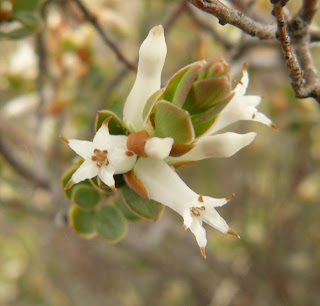Native Flowers of October
This post is going to be mainly about the native flowers which have come into flower in this month. Or, should I say, which we have noticed and/or photographed for the first time.
The next image is of some twining glycine. Note the three leaflets in each leaf: this is a feature to distinguish it from Hovea. This plant was particularly vigorous: most of the time it is twining along close to the ground, whereas this lot was up to 1.5m up is support plant.
The next is a nice daisy, Vittadinnia mullerii. I have juggled parts of two photos to show the flower and inset the foliage.
The next image is of Hardenbergia australis. This has been around for months but Frances noted this lot going for a world climbing record so it has been recorded.
The Bulbine Lilies arestarting to hit their straps, particularly in the Top paddock.
The middle paddock has a nice swampy bit with a watercourse leading to a small, and frequently over-full dam. This generated a lot of sundews, which after several weeks of vegetative growth were kindly generous enough to put out some flowers.
Nearby was a Lomandra filiformis. In vegetative mode this is a very reedy looking plant and not that appealing to the eye. When a flower is encountered however they are very attractive at close range.
Some more yellow things are beginning to happen. On 24 October I took images of Hibbertia obtusifolia (the Grey Guinea flower) and Corinidium scorpioides, an everlasting daisy.
The Corinidium is an example of the darker side of the forces of evil (aka taxonomists) at work. As far as I can establish Corinidium means "little club" which is no help whatsoever in identifying the plant. On the other hand the previous generic name 'Helichrysum' resolves to yellow sun which is a pretty good description.
A highlight of 24 October was the first flowering of Kunzea parvifolia, which is far less common here than its relative Kunzea ericoides which typically flowers in December.
While many parts of the day were yellow (see species above, plus Diuris) both of the non-orchids I photographed today turned out to be variations on the theme of purple. The second is Indigofera australis.
This is Leptorhyncus squamatus: Scaly buttons. When a few more of the yellow daisy looking plants have come out I will do a comparative page whenI get time. Do not hold your breath!
 |
| A hillside of Leucopogon fletcheri |
 |
| The first violet (Viola betonicifolia) |
 |
| But wait, there's more violets! |
 |
| Glycine clandenista |
 |
| Ajuga australis |
 |
| Yam Daisy (Microseris sp.) |
As well as the 2 species of Leucopogon (fletcheri and virgatus) another white heath has appeared. This is Brachyloma daphnoides or Daphne Heath.
 |
| Brachyloma daphnoides |
The next image is of Pultenaea procumbens one of the many 'peas'.
Closely followed by Daviesia mimosoides the ultimate egg and bacon plant.
This is also a 'fireweed' since it forms a dense under-storey and burns fiercely. Unfortunately the fires also assist in germinating the seeds, so a controlled burn (excuse the oxymoron) merely generates an additional fuel load into the future. Fortunately we don't have much of this.The next is a nice daisy, Vittadinnia mullerii. I have juggled parts of two photos to show the flower and inset the foliage.
The next image is of Hardenbergia australis. This has been around for months but Frances noted this lot going for a world climbing record so it has been recorded.
The Bulbine Lilies arestarting to hit their straps, particularly in the Top paddock.
The middle paddock has a nice swampy bit with a watercourse leading to a small, and frequently over-full dam. This generated a lot of sundews, which after several weeks of vegetative growth were kindly generous enough to put out some flowers.
Nearby was a Lomandra filiformis. In vegetative mode this is a very reedy looking plant and not that appealing to the eye. When a flower is encountered however they are very attractive at close range.
Some more yellow things are beginning to happen. On 24 October I took images of Hibbertia obtusifolia (the Grey Guinea flower) and Corinidium scorpioides, an everlasting daisy.
The Corinidium is an example of the darker side of the forces of evil (aka taxonomists) at work. As far as I can establish Corinidium means "little club" which is no help whatsoever in identifying the plant. On the other hand the previous generic name 'Helichrysum' resolves to yellow sun which is a pretty good description.
A highlight of 24 October was the first flowering of Kunzea parvifolia, which is far less common here than its relative Kunzea ericoides which typically flowers in December.
While many parts of the day were yellow (see species above, plus Diuris) both of the non-orchids I photographed today turned out to be variations on the theme of purple. The second is Indigofera australis.
This is Leptorhyncus squamatus: Scaly buttons. When a few more of the yellow daisy looking plants have come out I will do a comparative page whenI get time. Do not hold your breath!















Comments
Where is home?